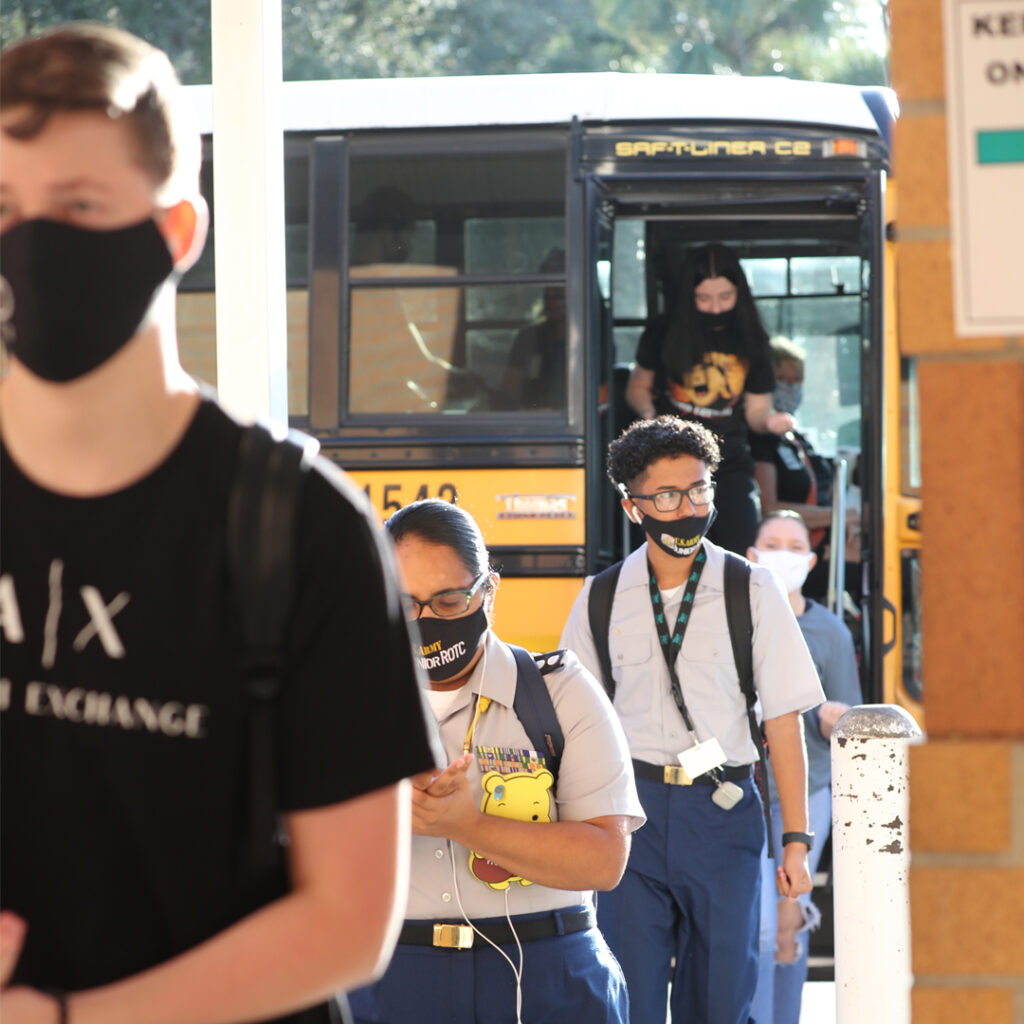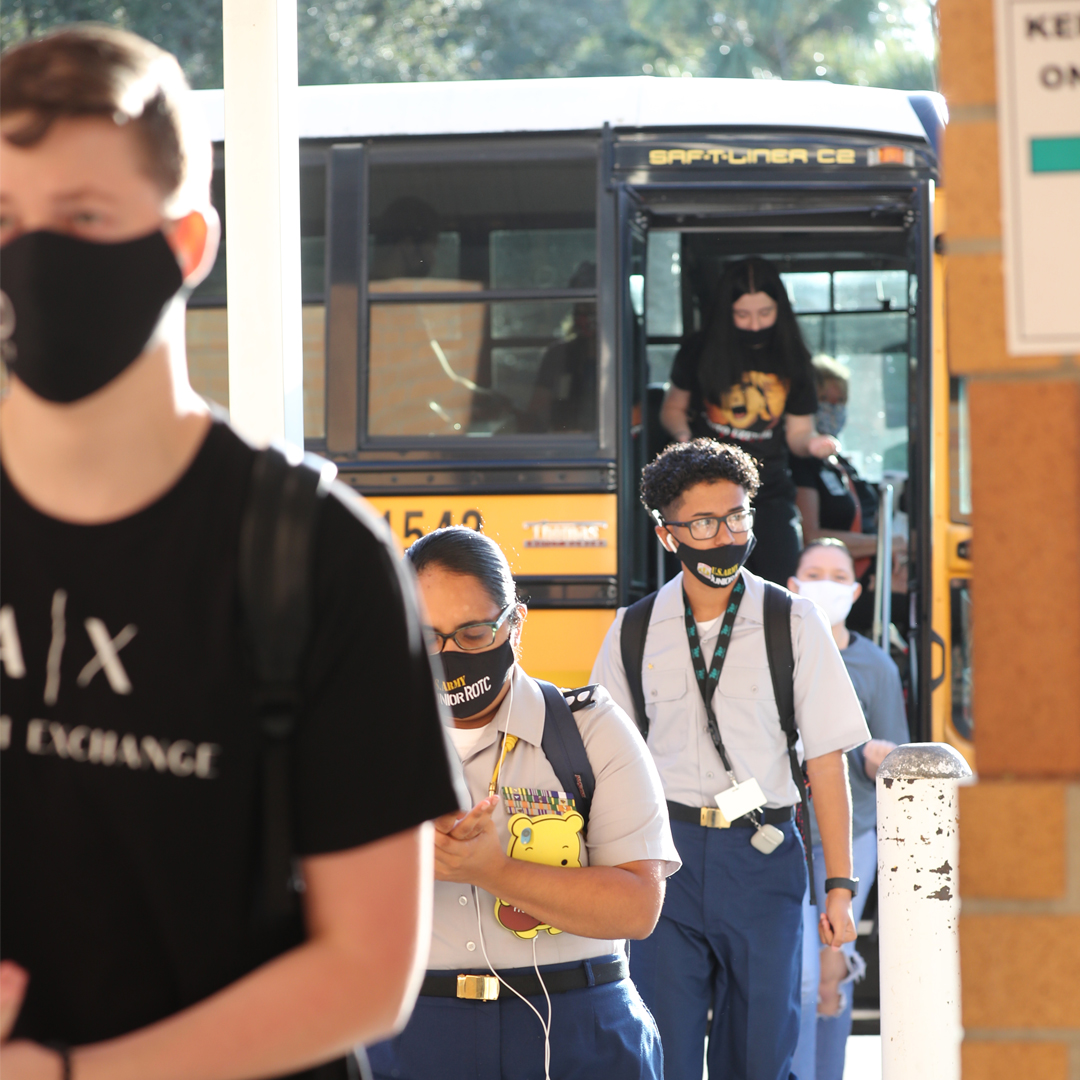At- and over-capacity schools under consideration

Students wear their masks as they get off their buses at West Port High School in Ocala, Fla. on Wednesday, Oct. 28, 2020. [Bruce Ackerman/Ocala Gazette] 2020.

In this file photo, students get off their buses at West Port High School in Ocala on Oct. 28, 2020. [Bruce Ackerman/Ocala Gazette]
At a joint Marion County Board of County Commissioners/Marion County Public Schools workshop earlier this month David Herlihy, the Planning & Governmental Relations Manager for Marion County Public Schools, noted in his presentation that despite low projections for enrollments in the coming years, Marion County currently has schools that are considered at or over capacity due to targeted growth within the county.
Stephen Ayres, Director of School Choice for Marion County Public Schools, said specific parts of the county are expanding the quickest.
“Southwest Marion County has seen a lot of growth and that is the area where, as a county, we are experiencing the most growth,” Ayres mentioned.
Ayres also recognized the dilemma of a current problem that is not expected to transform into a long-term issue and said programs such as Controlled Open Enrollment, also known colloquially as school choice, and out of area placements. are two ways the school district mitigates high enrollment numbers in schools dealing with capacity issues.
“We don’t want to make a snap decision on something that may be a temporary problem,” Ayres said. “And so, we do long range planning, but most of the way we handle that is through our open enrollment policies. And also, what schools we open and close.”
The Florida Department of Education (DOE) publishes the Florida Inventory of School Houses (FISH), which are guidelines and requirements for measuring a school’s capacity. It’s these guidelines, said Ayres, that dictate when a school is at or over capacity based on factors such as a school’s size and its student population.
In addition to school choice, portables, or “relocatables” as they are known in the school system, are another method Ayres mentioned MCPS utilizes to help alleviate some capacity issues.
“We do ship portables from school to school. College Park [Elementary], had some overcrowding so we shifted some portables from Oakcrest [Elementary] that has some extra capacity to College Park,” Ayres said.
While portables can help provide some temporary relief, Ayres pointed out that they have some considerations. Not only is there a cost to physically move the portables but there are infrastructure needs that must be met.
“Take Belleview Middle School for example. Even though the school has a lot more land space [than some other schools in the county] to possibly put portables on, there’s not the infrastructure, the plumbing, the electrical systems in place to support them,” Ayres said.
Outside of infrastructure concerns, portables are not a viable solution for schools such as Eighth Street Elementary School and Osceola Middle School, two schools that often face capacity issues, because Ayres noted, they do not possess the physical space to expand.
“Schools like Eighth Street or Osceola, which are landlocked and confined, we don’t have the ability to add more portables to them. That’s why we have a strict ‘You have to live in the zone to be able to get in there’ policy at schools like that,” Ayres added.
While it may seem like a feasible solution for MCPS to build new schools or add additional space in existing schools to alleviate capacity issues, Ayres said that decision must come from the DOE.
“The problem with adding capacity with the schools, even if it’s a district problem, is in order for us to build capacity we have to have approval from DOE,” he stated “We can’t just, as a district, go out and say, ‘Well, I want to build a school here.’ There’s an application process, because we have to make sure there’s equity in all the schools that are being built in the school district. And, also, we have to prove capacity or the need to DOE to be able to use tax dollars to do that.
Because of the targeted growth, while some schools face capacity issues, Ayres poined out, those in less growth-heavy portions of the county do not.
“We have schools in the north end of the county which have lots of open capacity. And, so, DOE won’t let us build either another school or add wings or add capacity to other schools when we have empty seats at other schools,” he said.
With building additions off the table as an option to reduce the current capacity issues, Ayres noted other possible solutions but said each has their own concerns.
“[If we can’t build additions onto existing schools], that’s when we have to look at possibly rezoning, busing, different things like that to try to alleviate overcrowding. But then, of course, at that point you have to judge ‘is this a temporary situation or is this more of a long-term solution?’ And once you start moving boundaries, that opens up a whole different process which can cause situations and issues on its own,” he shared.
Additionally, Ayres pointed out that the physical size of the county presents its own set of considerations, especially when it comes to zoning and districting.
“We have Fort McCoy middle and elementary schools, which have plenty of capacity to receive students. But in that zone, say Fort McCoy Elementary School, that zone is probably 10 times the size of say Eighth Street Elementary. So, the kids are riding a bus because it’s so sporadically populated,” he said.
“Once you start to try to draw a zone to encompass more students,” Ayres continued, “you then encroach on other school’s zones. You know, Ocala Springs [Elementary] would be in the Fort McCoy zone and we can’t have that.”
And COVID-19 added another variable into the situation.
“[When COVID hit] we did see a lot of movement out of Marion County but then we did see a lot of movement into Marion County because Marion County schools were open last year, whereas from other states they weren’t. So, parents were moving into Marion County because the schools were open. That was unpredictable, we couldn’t predict that…that will forever be a two-year asterisk, so to speak, on our long-range forecasting,” he added.
Despite the current issue of capacity at some Marion County Schools, during his presentation at the joint workshop, Herlihy’s future enrollment forecasting showed MCPS could expect to see between 50 to 350 student enrollments per year in the upcoming years.





